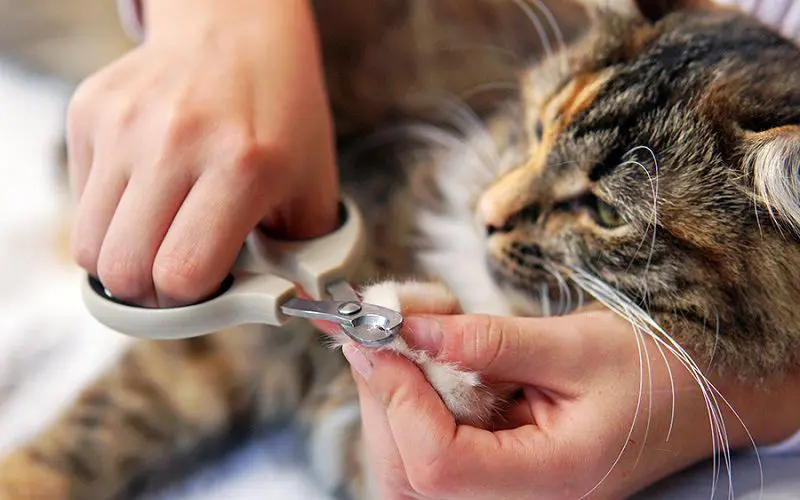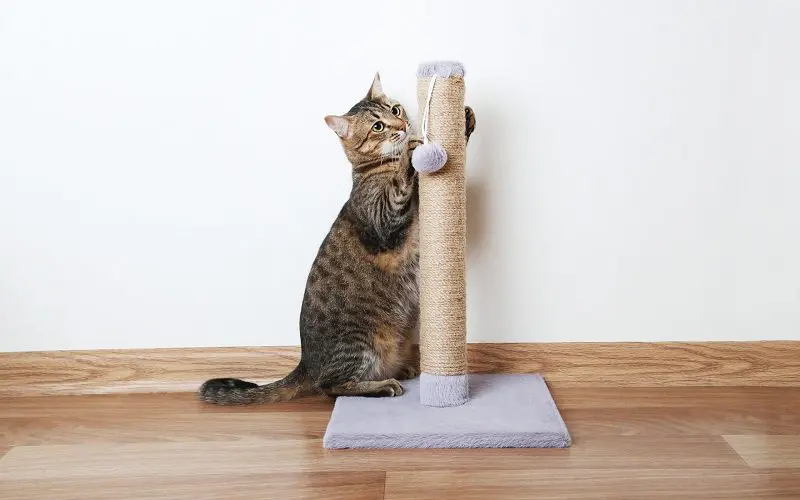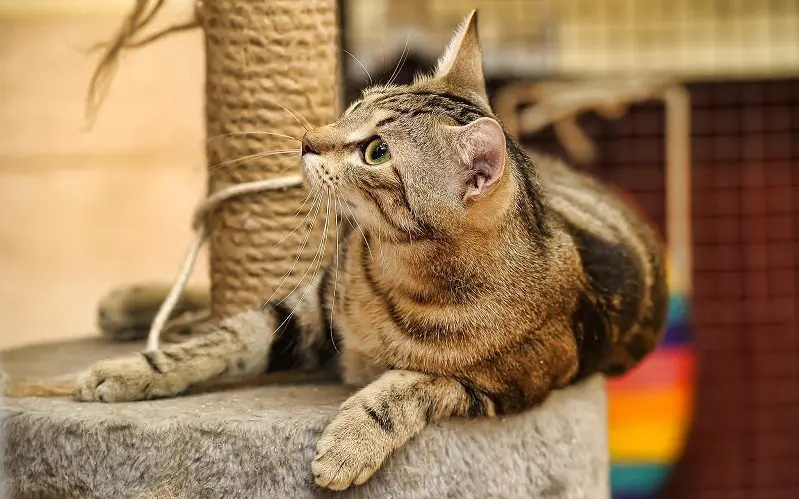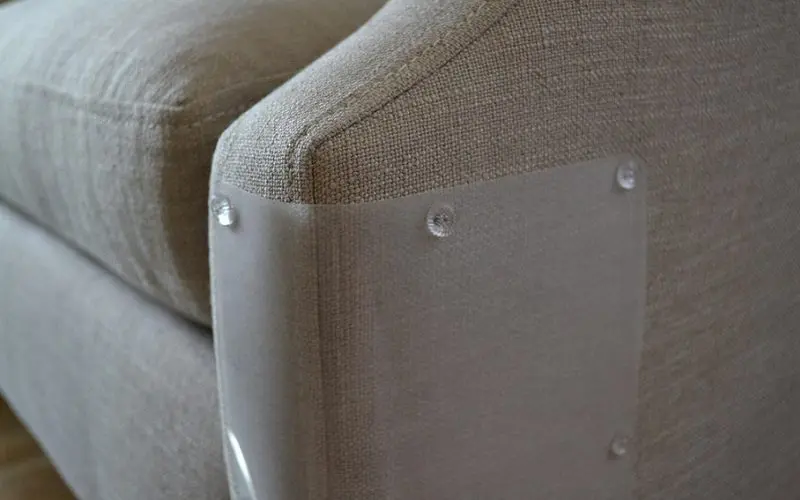Last Updated: 4 months ago
How do you stop a cat from scratching up your walls and furniture? The colleague asked me this question a day after she got a cat for the first time.
Most new cat owners scratch their heads on how to solve this problem, so we decided to lend a hand.
Below, you’ll find tips on how to stop a cat from destroying your furniture and everything else in your home!
Why Do Cats Scratch?

If you want to stop a behavior, you first need to understand why it’s occurring in the first place.
Do you know why your cat likes to scratch your furniture? It’s not because she is trying to get back at you for something or wants to destroy stuff.
Cats scratch because:
- It feels good
- It’s a way to mark their territory visually
- They are sharpening their nails
- They are stretching their muscles
- It relieves stress
- To explore! Cats are extremely tactile creatures.
What we’re trying to show you is that scratching is normal behavior, and it’s unavoidable.
If you don’t want your furniture, carpets, and walls to get damaged, you have to provide an alternative.
How to Stop Cats from Scratching Furniture Or Walls

Bad scratching habits should be nibbled immediately. Once Kitty gets comfortable with sharpening her claws on carpets, sofas, walls, or shoes, it will be twice as hard to make her stop.
And while some people would say that you can’t train a cat to do something she doesn’t want, you can save your furniture.
Just follow these tips.
1. Trim the Nails

To begin with, it’s important to have your cat’s nails trimmed regularly.
As I already said, cats scratch to sharpen their claws and remove the excess top layers. So, you can lessen the damage to your furniture by trimming Kitty’s nails regularly.
I know that it sounds like a hard job, but once you get your cat used to the procedure, it’s a piece of cake.
Moreover, trimming the nails means that they are less likely to get stuck on something and cause an injury.
Some people also suggest using nail caps in addition to nail trimming. These caps are plastic covers, which you put over the nails to prevent the cat from scratching the furniture.
We have such caps at home, but we never use them for two reasons:
- We’re afraid that the cat might swallow one accidentally.
- Scratching is a way for cats to relieve stress and if they can’t scratch, they might do something worse
Regular trimming keeps the nails short and, therefore, eliminates one reason that your cats are scratching up everything in the house.
2. Get Cat Scratchers

Another way to help stop cat scratching is to get a scratching post. Many posts come covered in carpet.
These posts offer your cat an outlet for their scratching needs by giving them a tactile experience and allowing them to explore with their paws.
Other, floor-based scratchers have a surface that’s similar to a nail file. This allows your cat to get their scratch on while simultaneously keeping their nails to a manageable length.
So, as soon as you observe that your kitten is eyeing a sofa or an armchair as a sharpening tool, go and buy a scratching post. It sounds easy, right? I wish it were.
Different cats like different textures. So, your furbaby won’t be satisfied with any cat post you buy for her. It has to feel right beneath her claws, or she is not going to look twice at it.
In addition to this, the scratching post must be the right size so that Kitty can stretch those muscles well.
If it’s too small or it feels unstable, Kitty is going back to her favorite sofa or that nice, long table leg.
My advice is to observe what your cat likes to scratch and get her something with a similar texture.
If you’re not sure, consider sisal because it’s similar to tree bark. But be prepared to try a couple of different options.
3. Teach the cat to use the scratching post

After you’ve brought the scratching post, place it around Kitty’s favorite scratching areas. You can entice her to check out the new acquisition by spraying it with catnip.
It’s possible that Kitty will walk away from the post after sniffing it for a couple of seconds. Do not despair.
- Wait for her to start scratching something she shouldn’t, for example, the armchair rest.
- Pick her up and take her to the scratching post.
- Place her paws on the surface and encourage her to dig her nails into it.
- Give her a treat and praise her.
- Repeat as often as needed.
You can also encourage the cat to use the scratching post by dangling a toy near it or placing treats on the top platform.
However, don’t bother spraying Kitty with a bottle or yelling at her when she goes back to the armchair. Cats associate the spraying and the shouts with your presence.
So, they won’t do whatever you’re “punishing” them for as long as you’re around. But when you’re at work, they do as they please.
4. Deter (Make the furniture unappealing)

Trimmed nails, scratchers, and cute cat trees are great starts, but chances are, you’ll need to do more than that.
Another critical part of training a cat not to scratch furniture is making her favorite scratching place unattractive.
Use your cat’s tactile nature to help deter him from scratching. Cover the inappropriate areas where your cat scratches with a coating that doesn’t feel good on his feet.
Effective coatings are double-stick tape, aluminum foil, or sandpaper. You can also help stop cat scratching by using scents that your cat doesn’t like.
In addition to covering walls, furniture legs, and other things that your cat is destroying by scratching, attach cotton balls soaked in citrus or menthol to the area.
Many cats hate those smells and will give the area a wide berth. You can do that by:
- Using sprays that repel cats
or using homemade ones
- Covering up the sofa or armchair with nylon
- Cover the armrests with double-sided tape
The point is that once her favorite surface doesn’t feel right, Kitty should redirect her scratching to the post you’ve so generously provided.
5. Try Claw Covers

Some owners opt to put claw covers on their cat’s nails. These rubbery covers slide snugly over the nail and are held in place with a light adhesive.
As the claws grow, the covers are pushed outward, eventually needing to be removed and replaced.
These can help keep your cat’s nails from damaging the house and give your cat a “splash of sass,” as one client at the vet where I worked used to say.
Stop Cat Scratching Without Declawing
We always advocate for preventative methods to stop cat scratching rather than declawing whenever possible.
Declawing a cat is a painful procedure, and a lot of cats have behavior problems afterward.
Those claws are an important defensive mechanism for the cat. Without them, a cat will bite when it feels threatened. As a result, your feline will get more aggressive and stressed.
This procedure should be a last resort when you have exhausted literally every other option on the planet and you can’t find a new home for your feline friend.
Finally, remember that when all is said and done, furniture is replaceable. So, do not get so angry when your cat destroys a couch or an armchair.
Just find the time and patience to teach her where it’s appropriate to sharpen her claws. Declawing is more aptly called deknuckling.
The reason a declawed cat has such soft, pillowy paws is that their nails aren’t the only things removed. When a cat is declawed, the first knuckle of each toe is actually what’s removed.
So if you need to stop cats from scratching in your home, try the methods above before considering a declaw.
It will save you money, save your cat discomfort, and allow him to continue to explore his world in the tactile way he was designed to.
Resources:


